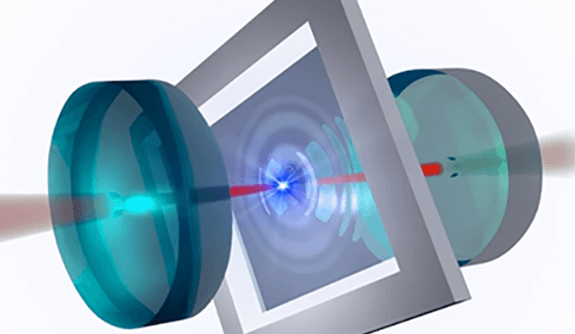Apr 4 2019
Imagine a situation where one hears the whisperings of people in the adjacent room, yet the very same people cannot hear the wild party taking place in that individual’s room.
 In the image, a flexible membrane (gray square) serves as an acoustic resonator, placed between two mirrors. When laser light is trapped between the mirrors, it passes repeatedly through the membrane. The force exerted by the laser light is used to control the membrane’s vibrations. (Image credit: Harris Lab)
In the image, a flexible membrane (gray square) serves as an acoustic resonator, placed between two mirrors. When laser light is trapped between the mirrors, it passes repeatedly through the membrane. The force exerted by the laser light is used to control the membrane’s vibrations. (Image credit: Harris Lab)
Now, Yale investigators have identified a method to do just that—that is, allowing sound to flow in a single direction—within a central technology present in everything from gravitational wave detectors to cell phones.
In addition to this, the scientists have applied the same kind of concept to regulate the flow of heat in a single direction. This latest finding offers new potential for improving electronic devices that utilize acoustic resonators. The study findings, from the lab of Yale’s Jack Harris, have been reported in the April 4th online edition of the journal, Nature.
This is an experiment in which we make a one-way route for sound waves. Specifically, we have two acoustic resonators. Sound stored in the first resonator can leak into the second, but not vice versa.
Jack Harris, Study Principal Investigator and Professor, Department of Physics, Yale University
Harris informed that his group successfully obtained the result with the help of a “tuning knob”— essentially, a laser setting—that can either strengthen or weaken a sound wave, based on the direction of the sound wave.
The scientists then took their experiment to another level. Since heat mostly contains vibrations, they used the same concepts to control the heat flow from one object to another.
By using our one-way sound trick, we can make heat flow from point A to point B, or from B to A, regardless of which one is colder or hotter. This would be like dropping an ice cube into a glass of hot water and having the ice cubes get colder and colder while the water around them gets warmer and warmer. Then, by changing a single setting on our laser, heat is made to flow the usual way, and the ice cubes gradually warm and melt while the liquid water cools a bit. Though in our experiments it’s not ice cubes and water that are exchanging heat, but rather two acoustic resonators.
Jack Harris, Study Principal Investigator and Professor, Department of Physics, Yale University
Some of the most rudimentary examples of acoustic resonators can be found in musical instruments and also in automobile exhaust pipes, but they can even be found in many different electronics. Acoustic resonators are utilized as transducers, filters, and sensors because they are compatible with an array of frequencies, materials, and fabrication processes.
Former Yale postdoctoral associate Haitan Xu is the first author of the study. Graduate student Luyao Jiang of Yale University and A.A. Clerk of the University of Chicago are the co-authors of the study.
The Air Force Office of Scientific Research, the Simons Foundation, and the Office of Naval Research supported the study.